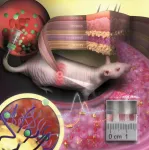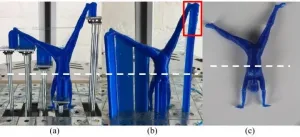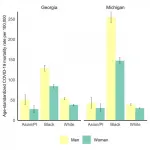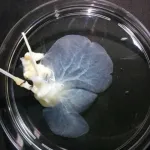(Press-News.org) Hamilton, ON (April 6, 2021) - If you are one of the millions of people worldwide suffering from allergies, you may take an antihistamine pill to ward off hives, sneezing and watery eyes.
But you may be taking your medications incorrectly, says Derek Chu, a McMaster University allergy expert and clinical scholar.
"People need to rethink what they stock in their home cabinets as allergy medicines, what hospitals keep on formulary, and what policymakers recommend. The message needs to get out. This publication is on time for the spring allergy season and as COVID vaccines roll out, for which rashes are common and antihistamines can be helpful," said Chu.
Co-author Gordon Sussman, professor of medicine at University of Toronto's Temerty Faculty of Medicine, agrees.
"There are new modern second generation antihistamines that are potent, specific, fast acting and of proven safety which everyone should be using to treat allergic rhinitis and hives," he said.
This team's study is published in the Canadian Medical Association Journal (CMAJ), and list five facts to know:
1. Antihistamines are among the most commonly and incorrectly used medicines worldwide.
Antihistamines are best used to relieve symptoms of hay fever and outbreaks of hives, but not for asthma, eczema, coughs or insomnia.
2. First-generation antihistamines are associated with substantial and sometimes fatal side effects.
Antihistamines with diphenhydramine, chlorpheniramine or hydroxyzine are first-generation antihistamines that can cause drowsiness and affect cognitive functions such as school performance. Overdosing can cause death and they are potentially dangerous for both young and older people.
3. Newer antihistamines are safer, as affordable and as effective as first-generation antihistamines.
Later-generation antihistamines are proven to be more effective and last longer with less side-effects like drowsiness.
4. Antihistamines should not be used instead of epinephrine to treat anaphylaxis.
Oral drugs can be used together with epinephrine injections to treat anaphylactic reactions, but they are not a substitute.
5. Most antihistamines are safe to use during pregnancy and breastfeeding.
Medical research has shown that antihistamines at standard doses do not harm fetuses during pregnancy and may be used during breastfeeding. They are also safe for children to use.
INFORMATION:
No external funding was received for this CMAJ article.
Editors: The paper is available post-embargo at http://www.cmaj.ca/lookup/doi/10.1503/cmaj.201959
For information, please contact:
Veronica McGuire
Media Relations
Faculty of Health Sciences
McMaster University
289-776-6952
vmcguir@mcmaster.ca
The idea of implantable sensors that continuously transmit information on vital values and concentrations of substances or drugs in the body has fascinated physicians and scientists for a long time. Such sensors enable the constant monitoring of disease progression and therapeutic success. However, until now implantable sensors have not been suitable to remain in the body permanently but had to be replaced after a few days or weeks. On the one hand, there is the problem of implant rejection because the body recognizes the sensor as a foreign object. On the other hand, the sensor's color which indicates concentration changes has been unstable so far and faded over time. Scientists at Johannes Gutenberg University Mainz (JGU) have developed a novel type of implantable sensor which can ...
In 2001, the famous herpetologist Joseph B. Slowinski died from snakebite by an immature black-and-white banded krait, while leading an expedition team in northern Myanmar. The very krait that caused his death is now confirmed to belong to the same species identified as a new to science venomous snake, following an examination of samples collected between 2016 and 2019 from Yingjiang County, Yunnan Province, China.
The new krait species, found in Southwestern China and Northern Myanmar, is described by Dr Zening Chen of END ...
A new study analyzing bean production and food security across 11 countries in sub-Saharan Africa, found COVID-19 pandemic-related restrictions to significantly impact bean production. Border controls and high transport costs have led to drops in production of the key food security crop, threatening to reverse gains made in achieving Sustainable Development Goals 1 and 2, towards no poverty and zero hunger, respectively.
Even before the pandemic, 55% of the world's hungry people and 70% of the world's poorest people lived in Africa, the researchers said. In addition, food systems across Africa were already affected by the adverse impacts of climate change, disease and pests, such as the worst desert locust outbreak in 70 years impacting food security in Kenya, Somalia, ...
3-D printing has the potential to revolutionize product design and manufacturing in a vast range of fields--from custom components for consumer products, to 3-D printed dental products and bone and medical implants that could save lives. However, the process also creates a large amount of expensive and unsustainable waste and takes a long time, making it difficult for 3-D printing to be implemented on a wide scale.
Each time a 3-D printer produces custom objects, especially unusually-shaped products, it also needs to print supports-printed stands that balance the object as the printer creates layer by layer, ...
Likely the first extinction event of the 2000s in Europe, the sad history of the Pyrenean Ibex (Capra pyrenaica pyrenaica) is a powerful example of the ever-increasing species loss worldwide due to causes related to human activity. It can, however, give us valuable information on what should be done (or avoided) to halt this extinction vortex.
The distribution of this subspecies of Iberian Ibex was limited to the French and Spanish Pyrenees. Its first mention in an official written document, dating back to 1767, already refers to it as extremely rare. Like many other mountain goats, it was almost hunted to extinction before its killing became prohibited in 1913. Neither the institution ...
Insomnia is a common problem in patients with schizophrenia, and a new study reinforces a close association between insomnia, more suicidal thoughts and actions and increased problems like anxiety and depression in these patients.
It also provides more evidence that keeping tabs on how patients are sleeping -- and intervening when needed -- is important to their overall care.
"We are now aware that significant insomnia is putting our patients at even higher risk for suicide, so if they are having changes in sleep patterns, if they are having significant insomnia, then we really need to hone in on those questions even more related to suicidal thinking and do what we can to help," says Dr. ...
A new paper in the Journal of General Internal Medicine published by the GenderSci Lab at Harvard University shows that Black women are dying at significantly higher rates than white men, and that disparities in mortality rates among women of all races are greater than those between white women and white men.
The study is the first to quantify the inequities in COVID-19 mortality looking at both race and sex group.
"This analysis complicates the simple narrative that men are dying at greater rates of COVID-19 than women," said lead author Tamara Rushovich, Harvard Ph.D. candidate in population health sciences and lab member ...
The adult human body produces hundreds of billions of blood cells every day. This essential process unavoidably leads to the appearance of mutations in the DNA of the progenitor cells. These are known as somatic mutations because they are acquired, not inherited. While most of these mutations are innocuous, occasionally a mutation gives affected cells a competitive advantage that allows them to expand progressively, generating clonal populations of blood cells. This phenomenon is known as clonal hematopoiesis.
Now, a team of scientists at the Centro Nacional de Investigaciones Cardiovasculares (CNIC) and the Hospital Universitario Virgen de Arrixaca in Murcia has discovered that the presence of these acquired mutations in blood cells increases ...
Below please find summaries of new articles that will be published in the next issue of Annals of Internal Medicine. The summaries are not intended to substitute for the full articles as a source of information. This information is under strict embargo and by taking it into possession, media representatives are committing to the terms of the embargo not only on their own behalf, but also on behalf of the organization they represent.
1. ACP Best Practice Advice: Shorter course of antibiotics may be appropriate for some common infections
HD video soundbites of ACP's president discussing the paper are available to download at http://www.dssimon.com/MM/ACP-antibiotics-paper.
Abstract: https://www.acpjournals.org/doi/10.7326/M20-7355
Free ...
Researchers at the Human Genome and Stem Cell Research Center (HUG-CELL), hosted by the University of São Paulo's Institute of Biosciences (IB-USP) in Brazil, have developed a technique to reconstruct and produce livers in the laboratory.
The proof-of-concept study was conducted with rat livers. In the next stage of their research, the scientists will adapt the technique for the production of human livers in order in future to increase the supply of these organs for transplantation.
The study was supported by FAPESP and is reported in an article published in Materials Science and Engineering: ...







